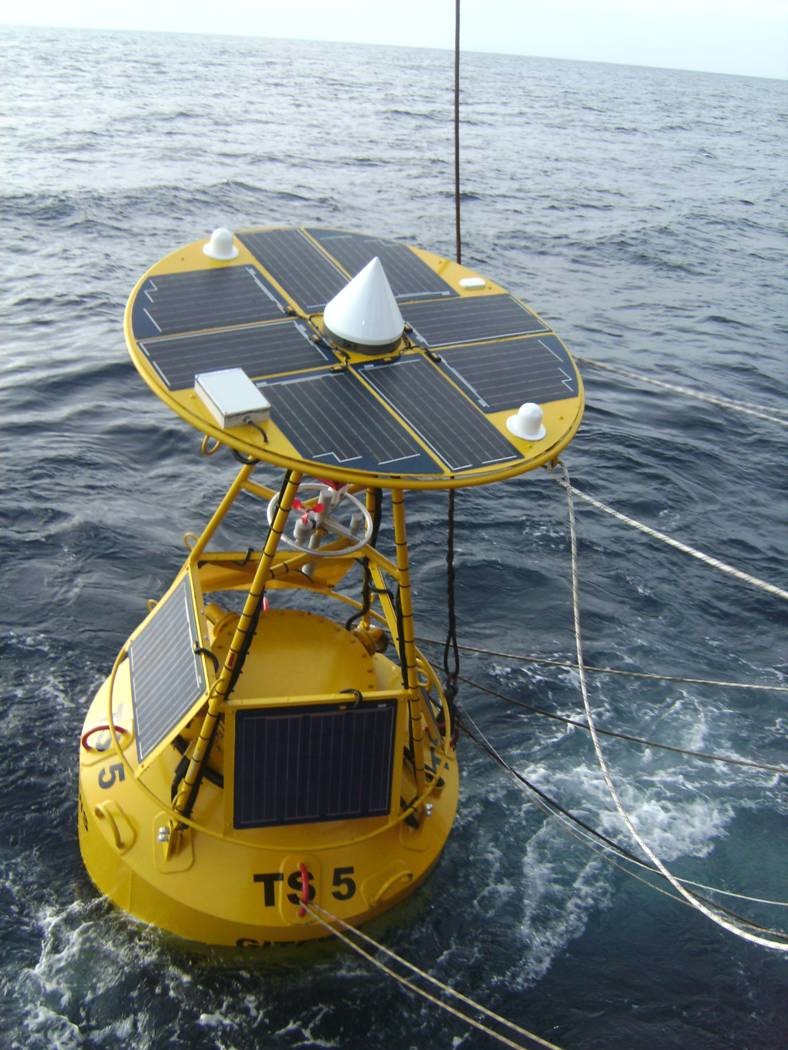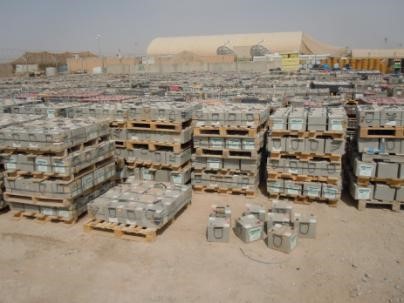
AMSAA looks at advances in solar energy as a way to maintain the batteries powering infrequently-used Army vehicles.
by Mr. Kevin Guite and Mr. Brian Frymiare
For those holding onto a restored 1968 Camaro in the garage or that old Ford F100 inherited from your uncle and sitting under the backyard tree, it should not be a shock to find that the batteries in those vehicles exemplify the axiom “use it or lose it.” The Army faces a similar challenge, though one of far greater magnitude, with its vast fleet of tactical wheeled vehicles (TWVs), which make up nearly 65 percent of the Army’s total vehicle inventory. The TWV category—approximately 400,000 vehicles—includes everything from lighter vehicles like the High Mobility Multipurpose Wheeled Vehicle and its variants all the way up to massive, multi-ton vehicles like the Palletized Load System.
Most of these vehicles stand by until needed, which means that nearly 75 percent of the TWV fleet can be characterized as low-usage, or operated fewer than 3,000 miles each year. Low-usage TWV systems have proven to be a big part of the Army’s battery failure-and-replacement cycle. These vehicles are critical components of the global sustainment mission, needed to transport supplies and equipment to and around the battlefield. But the reality of a “use it or lose it” approach to battery life quietly attacks the readiness levels of the fleet.

The 488th Military Police Company held their annual training this week at Plymouth Training Site in Plymouth. The training lasted over a week during which they conducted events such as vehicle recover, patrolling, security measures, Humvee operations, and vehicle maintenance. The training was also host to their annual event, the Best Military Police Squad Competition. This put nine squads from the unit head to head in a physical and mental test lasting 12 hours. The competition tested each squads, physical training, ruck march a, medical skills, radio communication proficiency, and much more.
Data acquired through the Army Sample Data Collection and Analysis (SDC&A) program highlights the accelerated battery replacement rate for the TWV fleet. The SDC&A program, established through DOD Directive 4151.18, collects and analyzes data to support cost, reliability, availability and maintainability studies; special requirements; and Army staff programs. The U.S. Army Materiel Systems Analysis Activity (AMSAA), as the Army’s responsible official, administers the program as prescribed in Army Regulation 750-1, Army Materiel Maintenance Policy. Based on SDC&A information, the Army is replacing some batteries only one-third into their expected minimum life and one-sixth of their expected life with proper maintenance.
For example, SDC&A data showed that over the past three years, the absorbent glass mat (AGM) battery used in the TWV fleet was being replaced every 13 months on average, when maintenance technicians detected the failure of the vehicle batteries. The expected minimal life of the AGM battery is three years as per manufacturer warranty, with an expected full life of approximately six to eight years when treated properly. The Army chose the AGM as its standard vehicle battery for its improved performance and spill-proof design based on the use of highly porous microfiber plates that absorb the battery’s electrolyte.
Replacing batteries has become a tremendous burden for the Army logistics enterprise. Maintenance personnel expend time assessing and recharging batteries, removing and replacing spent ones and managing temporary storage locations for batteries that are no longer useable. Removing the batteries from the site requires involvement of the Defense Reutilization and Marketing Office or local contractors paid to remove and recycle the batteries. During FY16, DOD spent more than $80 million replacing more than 373,000 vehicle batteries. The cost and effort being expended on low-usage batteries begs for a better way to manage this challenge.

A buoy equipped with solar panels monitors for tsunamis in the Indian Ocean. Solar panels today are lighter and more efficient than previous generations of the technology, requiring fewer panels to generate a given amount of electricity. (Photo courtesy of SOLARA)
A SOLAR SOLUTION DAWNS
Now engineers with AMSAA’s Operational Sustainment Analysis Team (OSAT), in coordination with other Army organizations, are exploring the possibility of using modern solar charger technology to solve the problem of prematurely replacing Army batteries. OSAT engineers, charged with detecting systemic materiel readiness issues in fielded systems and influencing improvements using data-driven analyses, are studying small solar panels that when attached to the hood or roof of TWV platforms can provide from 20 to 60 watts of power to charge and maintain batteries on those vehicles. Once attached, the solar panel can remain with the vehicle wherever it travels and requires no interaction or maintenance from the vehicle’s operator. By converting the sun’s power into electricity, solar panel solutions have the potential to increase the readiness of low-usage vehicles while reducing maintenance costs and the logistics burden caused by excessive battery management.
Solar panels are an old but still evolving technology that have gone though many advancements over the years. Bell Labs introduced solar cells for space activities in the 1950s that boasted 6 percent efficiency in converting light to power. Today’s panels, capitalizing on years of design and manufacturing improvements, are capable of converting sunlight into power at an efficiency level of about 20 percent. AMSAA’s analysis of previous efforts from as early as 2004 seeking to introduce solar chargers to Army vehicle maintenance programs uncovered problems stemming from design and implementation issues. At that time, the solar panels selected were too small for the load placed on them, and the panel controllers needed to govern battery charging voltages were not watertight or fused to protect electrical components in case of an electrical short. Multiple-battery configurations required for Army vehicle loads became unbalanced and were not properly regulated. Panels were not shade-tolerant, so the whole system stopped working when part of a cell was blocked from the sun. In addition, the panels were ultimately found to be too large, too heavy, too fragile and too expensive.
The latest generation of solar panels and controllers has been able to resolve many of the problems and concerns of earlier models. The solar panel industry has studied the problems experienced in the past, noted lessons learned and applied them to today’s products. Newer, lighter, flexible, more durable and less expensive panels are now operating with greater efficiency, reducing the size and number of panels required for the amount of power produced. Such panels can be found on rooftops, cars, street signs, buoys, remote communication equipment and even recreational vehicles. Waterproof controllers, proven during marine applications, with well-designed voltage regulators, are now available. Additionally, panels now include bypass diodes that can route power around shaded or damaged cells, allowing a solar panel to even incur multiple gunshots and continue to produce power without shorting out.

A battery disposal yard at Kandahar Airfield, Afghanistan. In fiscal 2016, more than 373,000 vehicle batteries were replace at a cost of more than $80 million to DOD. (U.S. Army photo by Chip Herrell, AMSAA)
CAN IT POWER THE ARMY?
The unique requirements of the Army’s military vehicle platforms pose challenges to fully maximizing solar panel advances. First, the Army uses batteries connected in strings of 12 and 24 volts. These series and parallel strings of batteries are similar to the 12-volt batteries found in automobiles; however, Army vehicles combine multiple batteries for its more robust vehicles, which require more voltage and power. For example, some TWVs require a configuration of four large 120-amp-hour AGM batteries. These vehicles require both 12- and 24-volt power to accommodate legacy and newer electrical components that have specific requirements for those voltage levels. The differing electrical loads they place on the vehicle’s battery bank often leads to large battery voltage imbalances. Research has shown that a one volt difference between the two 12-volt battery strings is not uncommon, but that one volt difference in an AGM battery is the difference between being 100 percent charged and approximately 20 percent charged. The huge discrepancy can cause many problems for military vehicle platforms.
AMSAA engineers, in coordination with other Army organizations, are leading an 18-month analysis initiated in June 2017 that will research, configure and test various solar panel and controller options for onboard vehicle battery charging of Army AGM battery configurations. The objective of the analysis is to identify requirements for a system that can cost-effectively charge, maintain, balance and restore Army TWV batteries. Research efforts to date have uncovered a number of products that appear to be suitable for the evaluation. The analysis will assess the various solar product configurations against a collection of new and discharged AGM batteries representing differing states of charge to determine if today’s solar panel products are able to maintain new batteries, remove sulfation from the battery plates that limits battery power capacity, and restore undercharged or dead batteries. AMSAA will study controllers for their ability to govern power distribution to banks of batteries and to operate in adverse weather conditions. The analysis also will consider panel size, flexibility and survivability in a variety of Army operating environments. The ultimate goal is to be able to produce requirements that the Army could adopt for a solar charger system that could be installed easily on fielded and future TWV platforms to extend vehicle battery life.

Not even the weight of a forklift can damage some of today’s solar panel products. The solar panel industry studied past problems, noted lessons learned and applied them to today’s products; AMSAA engineers are now working to develop requirements for a solar-powered charger system to mount on the Army’s light tactical vehicles. (Photo courtesy of SOLARA)
CONCLUSION
Given the recent advances in solar technology, the time is right for the Army to consider the use of solar charging systems. By properly using efficient and robust solar charger systems, the Army will be able to maintain vehicle batteries within their low-usage TWV fleet so that they will not need to be replaced until their full expected lifetime of six to eight years. The current generation of solar products is considerably less expensive than those from just a few years ago. The Army stands to benefit greatly from that cost reduction, by identifying and implementing a cost-effective solution to solve a historically challenging maintenance concern.
For more information on this and other AMSAA OSAT efforts, contact the authors at kevin.m.guite.civ@mail.mil or brian.e.frymiare.civ@mail.mil, or go to https://osat.amsaa.army.mil.
KEVIN GUITE is a lead operations research analyst for AMSAA at Aberdeen Proving Ground, Maryland. He holds an M.S. in computer science from the University of Maryland Graduate School and a B.S. in computer science from the University of Maryland Baltimore County. He is Level III certified in engineering and Level I certified in program management. He has been a member of the Army Acquisition Corps since 2008.
BRIAN FRYMIARE is a general engineer for AMSAA. He holds an M.S. in management from the Florida Institute of Technology and a B.S. in general engineering from Widener University. He is Level II certified in test and evaluation and in engineering.
This article will be published in the January – March 2018 issue of Army AL&T magazine.
Subscribe to Army AL&T News, the premier online news source for the Acquisition, Logistics, and Technology (AL&T) Workforce.







